Philae Temple
The cruise docked at Aswan overnight and early the next morning after breakfast, we set out to see the sites of Aswan. The most important ancient site near Aswan is the Philae Temple Complex. The Philae Temple Complex is a group of temples that were built over the span of thousands of years. What remains today are temples primarily built during the Ptolemaic and Roman times of Ancient Egypt’s history.
The main temple at Philae is dedicated to Isis. The temple was originally constructed by Ptolemy II (323-30 BC) who built the temple in honor of his wife, Arsinoe II. He dedicated the temple to Isis because he believed her to be Arsinoe’s protector. The temple contains two main halls, one for worshipping Isis and the other for worshipping Osiris. Augustus (63 BC-14 AD) later added other structures nearby including a library, theater, amphitheater and bath. The last emperor to make additions to the temple was the Roman emperor Hadrian (117-138 AD), who added a gate west of the complex. The temple was used well into the Roman rule of Egypt and was closed during the reign of Justinian I (527 – 565 AD) when it was converted into a church.
Philae Temple was originally constructed on the island of Philae with a long history associated with the worship of Isis. When the Aswan Dam was constructed in 1898-1902 and then heightened in 1907-1912, most of the Temple of Philae except for its highest parts, became submerged under water for part of the year. There were local voices of concern, but nothing was done about it. When the High Dam was approved for construction in 1960, it was predicted that the Temple of Philae would be completed flooded by water and the strong currents would cause irreparable harm to the site.
A high-profile international team was assembled to disassemble the Temple of Philae and relocate it out of harm’s way, onto a nearby island, Agilkai. The terrain of Agilkai was altered to match that of the original Philae Island. The Egyptian government and UNESCO worked together to pump the surrounding area dry. Archaelogists painstakingly disassembled, cleaned, treated, labeled and stored over 47,000 pieces from the temple. They then transported them and reassembled the temple onto Agilkai in exacting detail. The whole process lasted 3 years from 1977 to 1980. This wasn’t the last ancient temple that had to be dismantled and reconstructed at a different location due to man-made effects on the Nile River. At the end of our Nile Cruise, we will also visit Abu Simbel south of Aswan which was also relocated with great fanfare to its current location.
Since Philae Temple is located on an island, the only way to reach the island is by boat. The boat dock in Aswan was lined with vendors selling tourist trinkets. The Egyptians in Aswan look very different from those we have seen in Cairo and Luxor. This area and much of Upper Egypt was once a part of the Nubian Kingdom, that in ancient times stretched across South Egypt and North Sudan. The Nubian civilization is believed to be as ancient as the Egyptian. The people are dark-skinned and are culturally and ethnically distinct from the Egyptians. The most fascinating thing about the Temple of Philae is that it stands at the intersection of four major eras – the ending of the Pharaonic era, the Ptolemaic era, the Roman era and the Christian period. The temple is at the crossroads of religions, cultures, languages and civilizations that are all reflected on the walls of the temple. It is believed that the hieroglyphics on the walls of the temple are among the last time hieroglyphics were ever used on a large monument. After that, hieroglyphics were forgotten and lost to the sands of time, only to be understood again with the discovery of the Rosetta Stone nearly 2000 years later.
High Dam
Since the beginning of Egyptian civilization, the annual flooding of the Nile River has been both the lifeblood and the destroyer of life along the Nile. Because the timing and amount of flooding has always been unpredictable, it often caused widespread destruction. In years of drought, there was famine, and in years of over-flooding, there was destruction to villages and farms.
In 1902, the Low Dam was built to control the flooding of the Nile and regulate water availability for agriculture. In years with ample water, water could be stored for use in lean years, thus avoiding flooding and famine. Several years after the completion, it was discovered that the Low Dam did not provide sufficient capacity for water storage. It was raised twice around 1912 and again around 1933. Even with the raisings, the dam still fell short of providing for the water demands of the surrounding farmland. So, in 1960, engineers began to investigate the possibility of building a high dam.
The Aswan High Dam was completed in 1970. The High Dam is a feat of engineering and comes with many benefits. It better controls flooding of the Nile River, has a greater capacity for water storage and generates hydroelectricity. At the time when it was completed, it provided about 50% of the electricity in the country. The dam also created a fishing industry in Lake Nasser, the reservoir created by the water stored from the dam. The High Dam has had a major effect on Egypt’s economy, the lives of the people living around the Nile River and agricultural production in Egypt. As with any major infrastructure project, these benefits don’t come without a cost. During the construction, over 90,000 Egyptians and Nubians had to be relocated. Archaeological sites like Abu Simbel had to be taken apart and reconstructed on higher ground. As a result of the flooding being controlled, most of the rich silt and minerals are stuck in the reservoir and canals and are no longer deposited on the banks of the Nile. Chemical fertilizers have been used to make up for the lack of nutrition in the soil, thus resulting in a negative environmental impact.
Our guide Omar told us about a dam that is being built in Ethiopia called the Grand Ethiopian Renaissance Dam on the Blue Nile, the source of 85% of the water that flows into the Nile River. The Nile is the lifeblood of Egypt and it provides almost all of the country’s fresh water supply for everything from household use to agriculture. Ethiopia wants the dam to generate hydroelectricity for its people, the majority of whom currently don’t have electricity in their homes.
Since construction began in 2011, Egypt has strongly opposed construction of the dam because it believes it will strangle the downstream waterflow through Sudan and Egypt. Talks between Egypt and Sudan have failed many times while Ethiopia has continued to move forward with the project. In August 2023, Ethiopia announced that it had already finished filling the new reservoir at the new dam despite Egypt’s repeated insistence that the filling period be lengthened to at least 12 years.
This is an ongoing issue that experts say could escalate into armed conflict. We had some interesting conversations about this current event with the kids that touched on conflict resolution, international relations, negotiation strategies, territorial rights, personalities of leaders and limited resources. Ofcourse there is no right or obvious answer how to solve this conflict but that sure didn’t stop the kids from coming up with some interesting ideas like voting, discussion, all-out war and one-on-one hand-to-hand combat. The most amusing idea that came up was a game of rock-paper-scissors, two out of three games. Rock-paper-scissors is a method that we teachers often use on the playground when a conflict arises that needs to be dealt with quickly. But problems aren’t so easily solved in the complicated world of adults especially when a lot is at stake.

Unfinished Obelisk
The Unfinished Obelisk is a granite obelisk that lays horizontally because it was never completed. It measures about 40 meters in height but probably would have stood 70 meters tall upon completion. Archaeologists believe it was commissioned by Queen Hatshepsut and would have been erected at the Temple of Karnak. Nobody knows for sure, but the leading theory as to why it was abandoned is because a large crack developed during its construction that was believed to compromise its structural integrity. There are also other theories including the engineers bit off too much they could chew and realized they didn’t have the technical expertise to complete it. Another possibility is that Queen Hatshepsut died before the obelisk was completed and the project was abandoned by her stepson Tuthmosis III.
The highlight of the visit came after seeing the archaeological site itself. To reach the parking lot, we had to walk through a long corridor lined with tourist shops. Most of the shops sold tourist trinkets that we have seen many times before but one small shop with old photographs caught my eye. After some time browsing, I selected a photo of Al-Azhar from the early 20th century. The shopkeeper motioned for us to follow him to another shop that he said had the same owner. We walked a few steps to an English language Egyptophile bookshop with the largest selection of books on anything to do with Egypt that I have ever seen. I could have spent all day in this bookstore but we didn’t have too much time because we had to make it back to the cruise ship for lunch. I glanced at a display shelf and among the books, found the series “Alix’s Journeys of Discovery” that I have coveted since the first time Omar showed to books to us at Queen Hatshepsut’s Mortuary Temple. Without hesitation, we bought the three-part series on Ancient Egypt along with two photos of Al-Azhar and went on our merry way.
Nubian Village
The Nubian Village was not part of the pre-planned itinerary; it was an optional excursion offered by the tour operator. We heard from our new friends on the cruise that it came highly recommended, so we were curious to go. The price offered by the tour operator was quite high and was on a per person basis. I knew I could get a better price from a local so I contacted the owner of the small guesthouse we booked for one night in Aswan. He was able to arrange our visit to Abu Simbel for a very good price so I knew he was the man for the job.
Mohammed immediately responded to my WhatsApp and said he could organize a local boat to take us to the Nubian Village. It was just a fraction of the price of the “tour”. Once we arrived at the village, we could explore on our own.
Ancient Nubia is one of the most ancient cultures on Earth, going as far back as 8000 years. They are more ancient than even their Ancient Egyptian neighbors. The Nubians were originally a nomadic people from Northern Sudan. They settled in Southern Egypt with their sheep, goats and cattle. At some point, they began to farm the land along the fertile banks of the Nile. The Nubians were well known to the Ancient Egyptians. At times, they were friendly neighbors who engaged in peaceful diplomacy and trade and sometimes, they were enemies at war. I remember seeing the relief of Rameses III defeating his enemies, among them the Nubians, at the Mortuary Temple of Rameses III at Medinet Habu in Luxor. Over time, the dark-skinned Nubians intermarried with Egyptians and assimilated into one culture.
The local wooden boat picked us up where the cruise ship was docked. It turns out that the highlight of the visit was the boat ride to the village. We went through an intimate, peaceful stretch of the Nile River that was so different from the wide, busy stretches that we had come to know during the past few days as we cruised from Luxor to Aswan. The boat navigated through large river boulders and dense growths of reeds. I imagine it was more akin to how life along the Nile River must have been in ancient times when there was much less commercial activity.
At one point, we saw a couple of young boys paddling in the river on something that looked like a surfboard. We thought they were playing around in the river. One of the boys paddled up to our board and held onto the side of the boat and began to sing. Then we realized that they were trying to earn tips. We had a discussion with the kids about why these young children would put themselves in danger to try to earn money. Throughout our time in Egypt, it has been difficult to know how to treat those asking for tips, especially children. Although we were not in unanimous agreement, we gave a tip to this boy after he sang a few songs.
The Nubian Village is a tourist village made up of colorful clay buildings that hugged the bank of the river. Some might consider it a tourist trap because it was clearly organized around making money from tourists. The village was lined with shops selling tourist trinkets and local crafts. There were many restaurants, cafes and small inns. Camel rides were available through the village. It didn’t take us more than ten minutes to walk from one end of the village to the other. RY and AY saw a high sand dune at the back and decided to climb to the top. We could see them struggling to climb up but once they made it to the top, they sat at the top and enjoyed the expansive views.
Altogether we probably spent no more than two hours at the Nubian Village. We climbed back onto the boat and headed back to the cruise ship, enjoying the glorious view as the sun set over the Nile River.
Author
-

Song is the mother of four children. She and her family have stepped away from it all and in September 2023, began traveling the world while homeschooling. Song is an ABC (American born Chinese) and has an undergraduate degree from Cornell and an MBA from Harvard. She is an entrepreneur and an educator. Her hobbies include learning, traveling, reading, cooking and baking, and being with children.

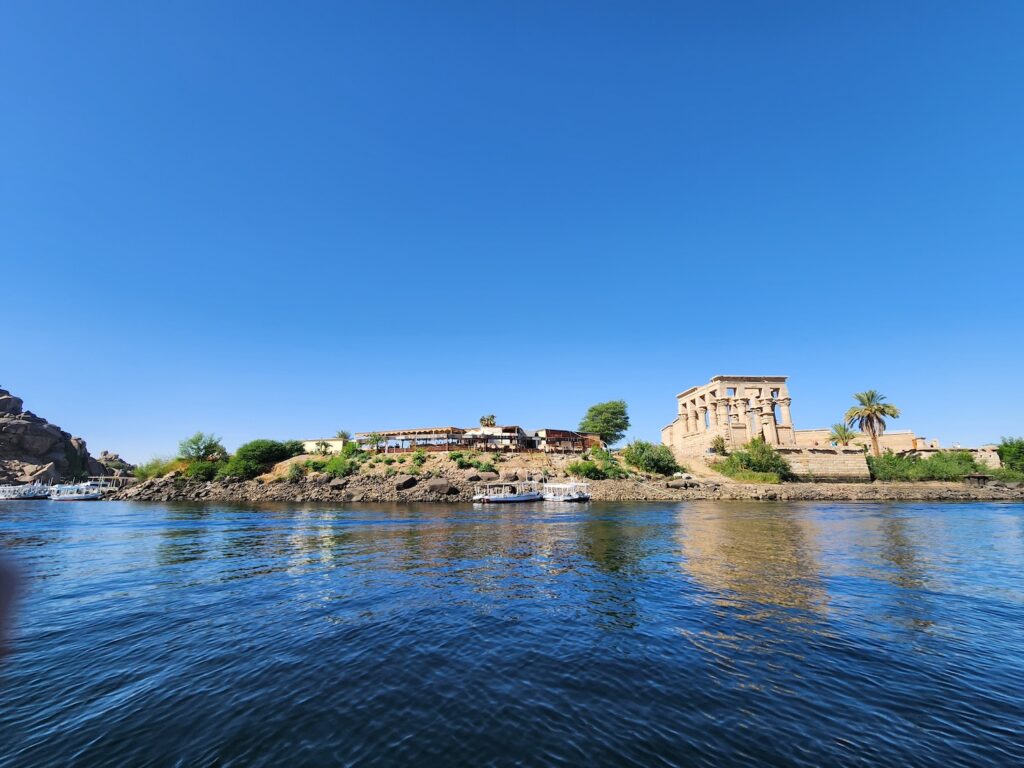


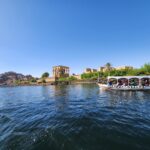
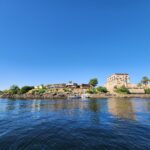





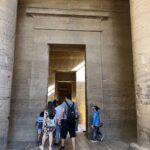

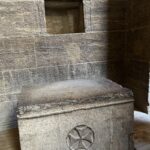
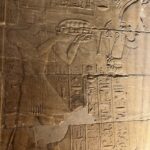

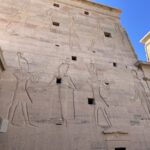
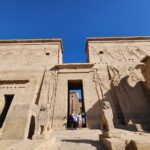
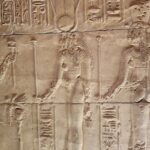

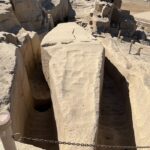



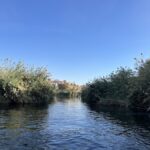

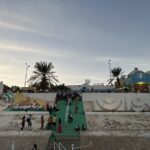
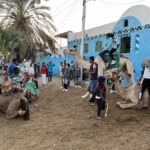


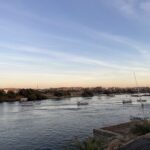

11/23 菲萊神廟,阿斯旺高壩,象島努比亞村
菲萊神廟菲萊島,切割遷移重建造。
供奉愛神伊西斯,免於建壩淹國寶。
阿斯旺壩重力壩,世界聞名高大壩。
納賽爾湖堰塞湖,防洪發電效益大。
努比亞村有特色,河畔蘆葦水清澈。
村屋牆外畫鮮豔,登山觀景童兩個。